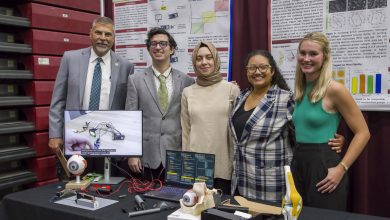Florida Tech Research Providing Jets Parking Solutions
No matter your level of fandom or your team of choice, one thing all patrons at major sporting events share is the dreaded exit after the big game. After the thrill of a live sporting event, the ensuing process of heading home often involves deadlocked traffic, rising tempers and many minutes of waiting.
New Florida Tech research is seeking a solution for one major venue.
As part of a partnership between the Melbourne university and the National Football League’s New York Jets, Florida Tech civil engineering assistant professor Rodrigo Mesa-Arango and students in his transportation engineering class analyzed the Jets postgame parking lot exit strategies at MetLife Stadium.
Mesa-Arango and the class looked at data that included parking lot capacities and prices, nearby train capacities and run times, and foot traffic following an NFL game. They also examined postgame exit data from the Miami Dolphins’ Hard Rock Stadium and the New England Patriots’ Gillette Stadium. The 25-student class was broken into five teams, each with a unique team name and a plan for potential solutions.
Devising and considering solutions that included postgame events to keep more fans at the stadium, allowing exits to flow easier for those who opt to leave, to the use of contraflows –where the lanes of traffic all go one direction during a certain period – Mesa-Arango’s students provided solutions as creative as their team names.
- The Traffic Solutions Management team, comprised of Sultan Alsubaie, Clayton Davis, Fahad Helabi, Mansour Qumayr and Vicky Pena, developed a maintenance of traffic plan that would create detours towards the State Highway Routes 3 and 120. The team also use the SafeTripNJ app to improve safety on the state’s major toll roads as well as an addition of ramp meters.
- Dream Team, comprised of Justin Barney, Rodnie Bernard, Samantha Bischoff, Harry Craik and Mark Iacobino, created a plan that would delay exit parking lots, allowing for an easier flow of traffic.
- H, M & N Engineering Group, comprised of Harris Halabi, Marianna Maltsev, Maggie Peck, Neilan Salerno and Nicholas Shore, devised a plan that featured a combination of traffic counting, dynamic message signs, slanted double-deep parking with one-traffic lanes, better signage, and new traffic orientation.
- Group 4, featuring students Amanda Allen, Abdulrahman Alsharari, Rachel Kraak, Anthony Ojukwu and Nikola Selakovic, had a plan that would locate dynamic message signs in select locations.
- Literally the Most Complex Traffic Issue in the NFL, comprised of Zachary Isbell, Kieran Jones, Bosco Mambo, Rachael McMahon and Brandon Williams, made a plan to redesign exit operations, including protected merging, toll both lanes and alternative tolling.
When asked about the biggest factors in the traffic situation at MetLife, Mesa-Arango cited issues familiar at major event venues nationwide: patrons leaving at the same time, which severely clogged parking lots and transit areas.
Overcoming that gridlock takes more than just signs and altered traffic patterns, he noted, as long-time fans may have a different outlook on parking changes than casual ones.
“They’ve been going to the stadium for 10 years, and they tailgate in the same place, and they want to expect the same traffic performance,” he said. “So asking them to change their behavior is a big challenge. We need to be empathetic with the desires of people, especially when designing infrastructures for pedestrians and transportation users.”
Once the final presentations are completed in early December, Jets officials will review the plans and decide how to proceed.
Mesa-Arango said the Jets’ help and flexibility with the process was very helpful, and if there is another opportunity to work on similar research, he would look forward to it.
“At the end of the day, giving students opportunities to interact with the real world and creating a mindset that is not only technical but entrepreneurial, I think that is the best work,” he said.
###




